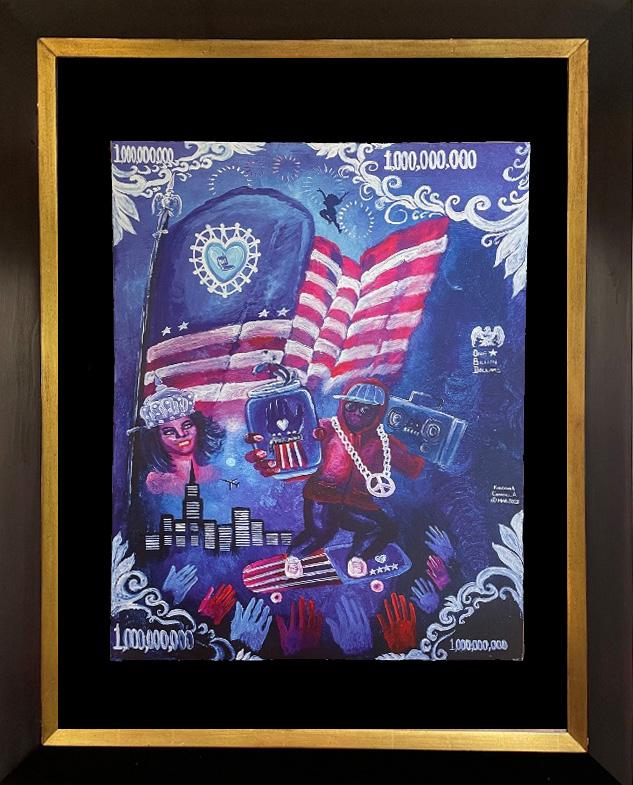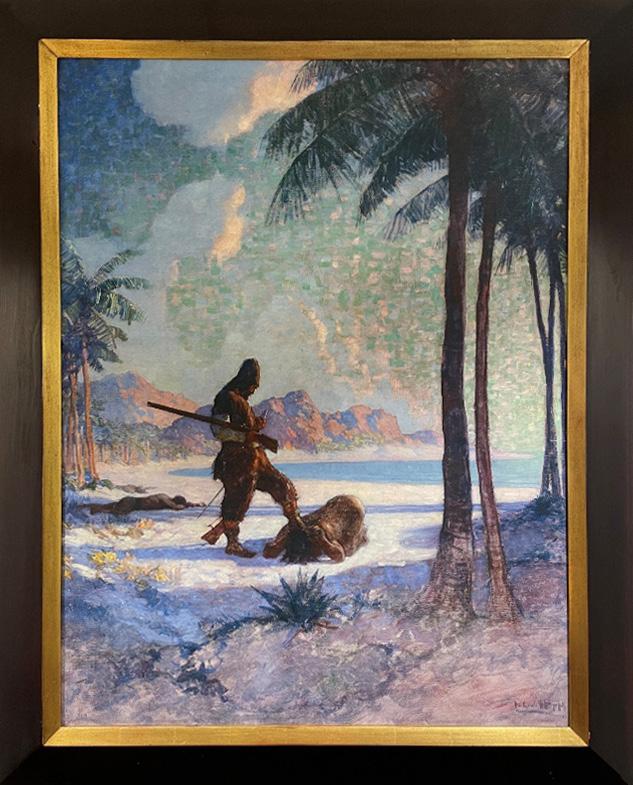
5 minute read
Fire on My Tongue
from DJPH - Homelessness, Poverty, and Public Health
by Delaware Academy of Medicine and the Delaware Public Health Association
Michael Kalmbach, M.F.A. Founding Director, Creative Vision Factory, Wilmington Delaware
“Let Your Life Speak” reads the sign that’s been winking at me on my commute home along Fourth Street in Wilmington (Figure 1). Knowing I ought to be more familiar with the Friends Meeting House on Quaker Hill, the ghost of Thomas Garrett lured me into turning the car around. When I found his barely legible tombstone, I knew exactly how I would let my life speak. It came to me at a Billy Strings concert in Atlantic City. Channeled by another ghost, this time my departed friend and colleague Michael Solomon. Solomon was the heart and soul of the Creative Vision Factory (CVF), a drop-in center that is both a large art room and a refuge for people who are poor, with psychiatric disability, homeless, or who otherwise find themselves marginalized and stigmatized on the streets of Wilmington. Solomon’s death was the hardest among the many we have endured in this era of housing, opioid, and COVID crisis. He loved Atlantic City. When Billy Strings played The Fire on My Tongue, I wept with a force. Peer support specialists are weary. Ours is a weariness that fuses with the families who have lost loved ones to overdose. It’s a weariness that holds space for our unhoused friends who prefer their freedom in tents and vacant buildings over having their homelessness treated with under-resourced behavioral health tools. May our weariness unite us, and may the fire on our tongues forge the stories needed to trigger cascading change.
Entering our fourth year of COVID, while grieving the loss of disability advocate Judy Heumann, the Creative Vision Factory is bearing witness to the daily humiliation and suffering of individuals experiencing homelessness while navigating multiple disabilities. The CVF regular who got a hard-fought extra day to stay in his hotel room, only to be struck by a car while attempting to cross Route 13 in his wheelchair. CVF’s most prolific artist, recently relegated to spending nights huddled under a dirty hospital blanket with his girlfriend who has cerebral palsy. An elderly woman we know who was turned away from the only shelter in the city on the premise that her disability is too great of a liability, and the fear on her heavily scarred face as she wondered how she was going to get through another cold wet night.
To write these words, to let my life speak through writing, I retreated from my frenetic work environment, always threatening to activate my PTSD, to the Wilmington Library, where I could steal an hour or two of quiet focus. Upon entering, I was taken aback by the numbers of Creative Vision Factory members among the available tables, greeting me with surprised smiles, daps, and looks of recognition. Being able to see our members supported by an infrastructure that I was not responsible for felt good on a molecular level. Writing in this room, and seeing people I have been in intense periods of crisis with quietly smile and nod as they walk by, has been a deep medicine.
Even here, however, there are reminders of the world from which we seek respite. In the library’s Rodney Square Room, like another wink from the ghost of Thomas Garrett, is a painting by N.C. Wyeth, from a series of commissioned illustrations for the 1920 release of Robinson Crusoe. The image is of Crusoe stepping on the head of the Indigenous Friday, after apparently slaying the figure in the background. This is why we need artists, poets, and storytellers reimagining the scope of our public institutions. To instead bear witness to such scenes as the tragic 2015 death of Thomas Cottingham in Rodney Square. Cottingham was an avid skateboarder known as Cannibal by his friends. The policing of Rodney Square after Cannibal’s death created a surge in CVF’s membership. By the time COVID stopped everything in March 2020, CVF stood out as one of the few remaining third spaces in downtown.

The composition of this Wyeth painting is strikingly similar to a painting currently hanging at the CVF. What kind of stories and supportive futures can we imagine when that painting, Knicoma Frederick’s One Billion Dollars, joins Wyeth’s in the Rodney Square Room (Figure 2)? Frederick has spent countless days and nights drawing and painting in Rodney Square. In his thousands of drawings lies the influence of the library’s architectural details, permeating his images of life in the city. The many characters and situational dramas that come to life in Frederick’s paintings bring to mind what the late Representative Phil Burton called the “raggedy-ass-lobby.” Writing in the Wilmington Library among the Creative Vision Factory members I can’t help but see Wilmington’s raggedy-ass lobby taking shape.
The pandemic exposed CVF and the Wilmington Library as critical pieces of infrastructure, the very fabric of a woefully underfunded social safety net. The victims of austerity and decades of disinvestment, these constituents are enduring the predictable outcomes of narratives woven around phrases like just say no, trickle-down economics, public-private partnership, and tough on crime. When I look at Knicoma Frederick’s One Billion Dollar painting, I can’t help but see it as a Phil Burton-like fever dream. Completed in March of 2020, just a week before the shutdown, the painting is of a skateboarder, looking like a Radio-Raheem-Uncle-Sam shooting across the city skyline. He drinks from a can celebrating the end of terrorism, and calls for an investment of one billion dollars directly into the hands of the people. Knicoma Frederick is the illustrator of our city’s streets. Through his works I’ve gained a deeper understanding of what it is to receive behavioral health services while experiencing homelessness in Wilmington. In Frederick’s words: “They’re always on time with the meds, and always late with the check.”

I Danced with the Delaware Stars on the floor of the Wilmington library with my colleague Sarah Lester, ultimately losing the trophy to my dearly departed friend and Wilmington Sitting Together Is Radical co-founder, Councilwoman Rysheema Dixon. I sat on that floor, in the same row as activist Bebe Coker and arts advocate Raye Avery, and listened to Marc Lamont Hill talk about his book WE STILL HERE: Pandemic, Policing, Protest, & Possibility1:
“As I reflect on the current moment, I see a widening sky of possibility. The public sphere is filled with radical voices, radical ideas, and radical action. We are dreaming together, envisioning a free and safe world where we finally turn to each other than on each other.”
We nurses, teachers, librarians, EMTs and peer support workers are weary, but we are not burned out. We’re heartbroken and under-resourced. The hollowing out of our social safety net has added layers of complex traumatic stress between the lines of our job descriptions. Some of us have protections. Others, after serving through their third winter of housing, opioid, and COVID crisis are rewarded with contract uncertainty, no collective bargaining, and historic inflation. If we are to realize the widening sky of possibility, the hard-earned wisdom of our weariness must be centered. We must turn towards one another and imagine the cascading change triggered by the decriminalization of all drugs. Imagine the lives saved when the drug supply is no longer contaminated. Imagine the trauma that would be eradicated by everyone having their own bed and private bathroom in a Delaware where our hospital systems are robust partners in the development of affordable housing. In the words of Billy Strings:
“The fire on my tongue is for those who die young, and the weariness of we who stay behind.”
Let our lives speak!
Mr. Kalmbach may be contacted at michael.kalmbach@gmail.com
References
1. Hill, M. L. (2020). We Still Here: Pandemic, Policing, Protest, & Possibility. Chicago: Haymarket Books.








